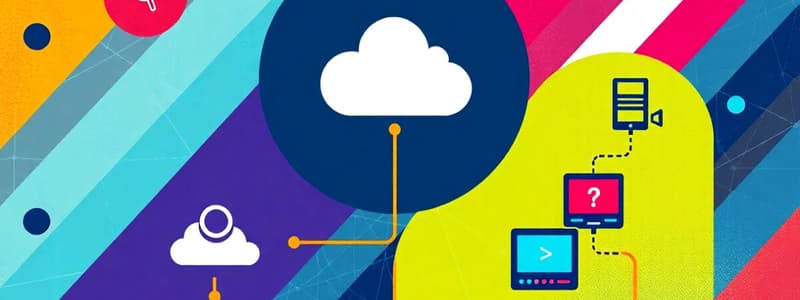Podcast
Questions and Answers
What is a potential pitfall related to project management?
What is a potential pitfall related to project management?
- Excessive stakeholder engagement
- Insufficient process mapping (correct)
- Overwhelming project team support
- Complete reliance on software implementation
What is one of the suggested options for appointing a project manager?
What is one of the suggested options for appointing a project manager?
- Hire a consultant to guide the team (correct)
- Choose a project manager with no certification
- Select the technical team lead as project manager
- Recruit an external project manager with no local knowledge
Which of the following options represents a common issue in project implementation?
Which of the following options represents a common issue in project implementation?
- Failure to assess the organization's politics (correct)
- Robust change management
- Complete team cohesion
- Detailed process mapping
Which issue can arise from a lack of top management support in project management?
Which issue can arise from a lack of top management support in project management?
What is an example of scope creep in project management?
What is an example of scope creep in project management?
What is the primary function of middleware in a three-tier architecture?
What is the primary function of middleware in a three-tier architecture?
Which of the following is NOT a characteristic of N-tier architecture?
Which of the following is NOT a characteristic of N-tier architecture?
Which statement about cloud computing is accurate?
Which statement about cloud computing is accurate?
Which security challenge is associated with using cloud computing in HRIS?
Which security challenge is associated with using cloud computing in HRIS?
What is a critical condition for the successful implementation of a best-of-breed architecture?
What is a critical condition for the successful implementation of a best-of-breed architecture?
What is a major drawback of two-tier and three-tier architectures?
What is a major drawback of two-tier and three-tier architectures?
What is the main advantage of using multiple vendors in best-of-breed architecture?
What is the main advantage of using multiple vendors in best-of-breed architecture?
How does n-tier architecture improve upon the limitations of two-tier and three-tier architectures?
How does n-tier architecture improve upon the limitations of two-tier and three-tier architectures?
In the context of cloud computing, which service category refers to complete software solutions managed by providers?
In the context of cloud computing, which service category refers to complete software solutions managed by providers?
What effect does the installation requirement of user interface clients have on HRIS access?
What effect does the installation requirement of user interface clients have on HRIS access?
What characteristic distinguishes a thick client from a thin client in an n-tier architecture?
What characteristic distinguishes a thick client from a thin client in an n-tier architecture?
Which of the following is a potential drawback of a three-tier architecture?
Which of the following is a potential drawback of a three-tier architecture?
What is one benefit of using web browsers in n-tier architecture?
What is one benefit of using web browsers in n-tier architecture?
What is the main function of a standard web server in n-tier architecture?
What is the main function of a standard web server in n-tier architecture?
What distinguishes the two-tier architecture from the one-tier architecture?
What distinguishes the two-tier architecture from the one-tier architecture?
Flashcards
Middleware
Middleware
A software layer that manages data and transactions before saving them to the database.
Two-Tier Architecture
Two-Tier Architecture
An architecture where the application logic is divided between a client and a server, and the database resides on the server.
Three-Tier Architecture
Three-Tier Architecture
An architecture that introduces a middleware layer between the client and server, enabling more complex application logic and improved scalability.
Network Traffic Constraint
Network Traffic Constraint
Signup and view all the flashcards
Client Installation Requirement
Client Installation Requirement
Signup and view all the flashcards
N-Tier Architecture
N-Tier Architecture
Signup and view all the flashcards
Thin Client
Thin Client
Signup and view all the flashcards
Thick Client
Thick Client
Signup and view all the flashcards
Cloud Computing
Cloud Computing
Signup and view all the flashcards
Software as a Service (SaaS)
Software as a Service (SaaS)
Signup and view all the flashcards
Platform as a Service (PaaS)
Platform as a Service (PaaS)
Signup and view all the flashcards
Infrastructure as a Service (IaaS)
Infrastructure as a Service (IaaS)
Signup and view all the flashcards
Best of Breed Architecture
Best of Breed Architecture
Signup and view all the flashcards
Interoperability
Interoperability
Signup and view all the flashcards
Steering Committee
Steering Committee
Signup and view all the flashcards
Customization
Customization
Signup and view all the flashcards
Insufficient Process Mapping
Insufficient Process Mapping
Signup and view all the flashcards
Change Management
Change Management
Signup and view all the flashcards
Scope Creep
Scope Creep
Signup and view all the flashcards
Study Notes
Three-Tier Architecture (Middleware)
- Middleware is software that manages data and transactions before they're saved to a database.
Drawbacks of Two-tier and Three-tier Architectures
- Two-tier and three-tier architectures experience high network traffic (bandwidth) between client and server during database transactions.
- User interface clients require installation (along with database drivers) on every PC needing HRIS access. This limits HRIS access primarily to employees within a company's physical location.
N-Tier Architecture
- Developers created a thin client (web browser) to address the drawbacks of two-tier and three-tier architectures.
- A standard web server manages HTML communication between the browser and the application server.
- N-tier architecture allows for scalability by allowing expansion across multiple web and application servers that can be geographically dispersed, facilitating load balancing and worldwide access.
- Additional print servers and process schedulers are also utilized.
- The architecture consists of a client (laptop, desktop, phone), internet, web server(s), application servers, and a database management system (DBMS).
HRIS Architecture
- One-tier architecture (Mainframe): All software functions accessed via a mainframe.
- Two-tier architecture (Client-server): Low-powered processing spreads through PCs, while high-powered processing happens on the mainframe. Application technology separates from database technology.
- Three-tier architecture (Middleware): Middleware manages data and transactions before they are saved to the database.
- N-Tier Architecture: Expandable to multiple web and application servers that can be geographically dispersed, allowing for load balancing and worldwide access. Includes additional print servers and process schedulers.
Cloud Computing
- A computing architecture that uses the internet and remote servers to maintain data and applications.
- "Server Cloud" Operated Off-site.
- Underlying goals are to reduce resources needed by companies maintaining and running databases and applications, thereby reducing software and equipment capital outlays.
- Three general service categories in cloud computing: Software as a Service (SaaS), Platform as a Service (PaaS), Infrastructure as a Service (IaaS).
Delivery model of cloud computing
- Delivery models categorized as SaaS, PaaS, and IaaS.
Security Challenges
- Exposure of sensitive payroll and benefits data between employees.
- Loss of personnel data (e.g., Social Security numbers) outside the company.
- Unauthorized updates of key data (e.g., salary, stock options).
- Sharing of personnel or applicant review comments with unauthorized individuals.
- Sharing data with external organizations and service providers.
Best of Breed
- Architecture that combines products from multiple vendors.
- Three conditions for synergy: perceived need for specialized software, significant usage of the internet for job applications, and the absence of a need for OCR programs for resume scanning.
- Universally agreed-upon guidelines for interoperability must exist between applications (e.g., XML). This allows for efficient data transfer between different HRIS applications (e.g., Resumix, Oracle's PeopleSoft, Chronos, ADP).
Security
- Top priority for HRIS systems.
- Security must be maintained at various levels (e.g., VPN, firewall, column-level, row-level).
EAI - Message Oriented Middleware
- A message-oriented middle-ware that incorporates numerous applications (e.g., HRIS system, ERP, legacy systems) into an overall architecture.
Planning System Implementation: Roles
- Project Manager
- Steering Committee/Project Charter
- Implementation Team
- Project Scope
- Management Sponsorship
Planning System Implementation: Key Activities
- Management Sponsorship
- Process Mapping
- Software Implementation
- Customization
- Change Management
- Go Live
- Project Evaluation
- Potential Pitfalls
Project Manager Options
- Hire a consultant as the project manager.
- Hire a full-time project manager (potentially certified by the Project Management Institute).
- Select someone already involved in the project and temporarily assign them project management responsibilities.
Potential Pitfalls
- Poor planning
- Incomplete steering committee or committee without top management support.
- Problems with the implementation team or an incomplete team.
- Failure to adequately assess organization politics.
- Insufficient process mapping.
- Scope creep.
- Poor implementation or insufficient change management.
Studying That Suits You
Use AI to generate personalized quizzes and flashcards to suit your learning preferences.
Description
Test your knowledge on project management pitfalls and strategies, as well as cloud computing architectures. This quiz covers key concepts like scope creep, middleware functions, and the challenges of vendor collaboration. Dive into the intricacies of project management and cloud computing in today's technological landscape.




